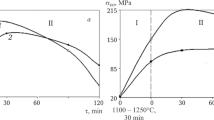Abstract
A classification of methods for manufacturing cast (without the use of vibration) ceramic castables is suggested and the mechanism of their structure formation is formulated. Cast (self-flow) castable mixtures with a moisture content of 4.8–5.5% are developed based on HCBS of quartz sand and a polydisperse silica filler (dmax = 1–7 mm). The mixtures are used to cast ceramic castables with an open porosity of 11–16%. After drying and heat treatment at 1200 and 1300°C their ultimate compressive strength is 6–14, 20–35, and 60–120 MPa, respectively. As compared with similar pressed and rammed ceramic castables; cast ones are characterized by a lower porosity and a substantially higher strength.
Similar content being viewed by others
References
Yu. E. Pivinskii, “New refractory concretes and binding systems: basic direction in the development, production and use of refractories in the XXI century. Part I. The trend of development, binding systems,”Ogneup. Tekh. Keram., No. 2, 3–12 (1998).
Yu. E. Pivinskii, “New refractory concretes and binding systems: basic direction in the development, production and use of refractories in the XXI century. Part II. Ceramic binders and ceramic castables,”Ogneup. Tekh. Keram., No. 3, 15–24 (1998).
Yu. E. Pivinskii, “New refractory concretes and binding systems: basic direction in the development, production and use of refractories in the XXI century. Part III. Spinel and cast (self-flow) castables,”Ogneup. Tekh. Keram., No. 4, 12–18 (1998).
E. Yu. Pivinskii, “New refractory concretes and binding systems: basic direction in the development, production and use of refractories in the XXI century. Part IV. Low-cement castables and cement-free unshaped refractories,”Ogneup. Tekh. Keram., No. 5, 2–10(1998).
Yu. E. Pivinskii, “Rheology and technology of ceramics and refractories. 6. Dilatant systems and factors determining their properties,”Ogneup. Tekh. Keram., No. 4, 2–14 (1997).
Yu. E. Pivinskii,Ceramic Binders and Ceramic Castables [in Russian], Metallurgiya, Moscow (1990).
Yu. E. Pivinskii, “Cast oxide refractories with a granular structure. Original compositions and laws of shaping,”Ogneupory, No. 6,6–11(1985).
Yu. E. Pivinskii, “Cast oxide refractories with a granular structure. Sintering, structure, and properties,”Ogneupory, No. 7, 10–16(1985).
Yu. E. Pivinskii,New Refractory Concretes [in Russian], BelGTASM, Belgorod (1996).
Yu. E. Pivinskii, K. V. Timoshenko, A. V. Cherevatova, et al., “Materials based on highly concentrated ceramic binding suspensions (HCBS). On shaping processes and the strength of silica mixtures based on plasticized HCBS of quartz sand,”Ogneup. Tekh. Keram., No. 8, 7–10 (1999).
B. A. Velikin, A. K. Karklit, S. V. Kolpakov, et al. (eds.),Lining of Steel-Casting Ladles, 2nd ed. [in Russian], Metallurgiya, Moscow (1990).
Author information
Authors and Affiliations
Rights and permissions
About this article
Cite this article
Pivinskii, Y.E., Timoshenko, K.V. Cast (self-flow) ceramic castables. 1. Fabrication and some properties of cast silica ceramic castables. Refract Ind Ceram 40, 442–447 (1999). https://doi.org/10.1007/BF02764197
Issue Date:
DOI: https://doi.org/10.1007/BF02764197



